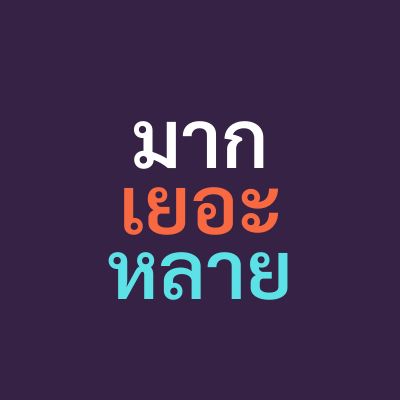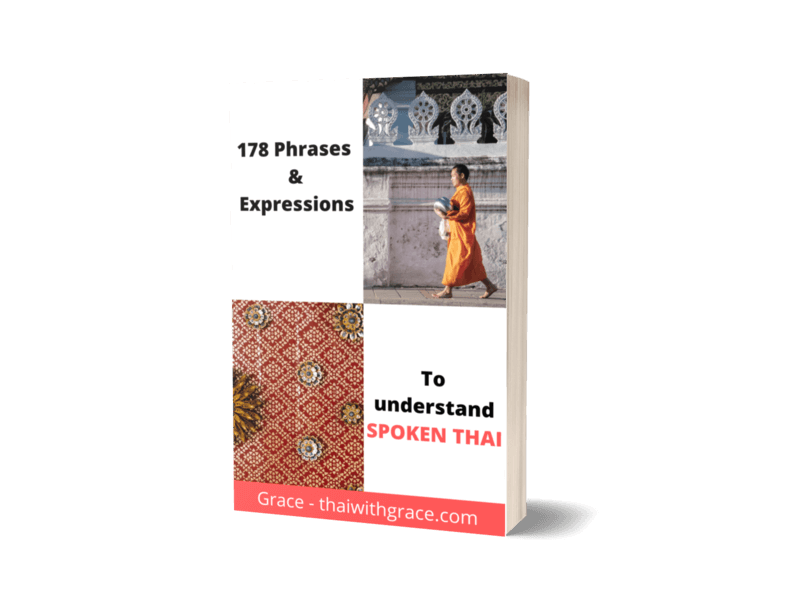There are 3 words to express many, much, a lot, very in Thai which often causes confusion. Here, I will explain the usage of มาก, เยอะ, หลาย (mâak, yúh, lăai) so you can use the correct one properly.
มาก mâak
One of the meanings of มาก (mâak) is to say ‘very’. The formula is: adjective + มาก. Let’s see some examples.
Examples:
- Very beautiful
สวยมาก
sŭay mâak - Very kind
ใจดีมาก
jai-dee-mâak - Very good
ดีมาก
dee mâak
Some other common adjectives used with มาก are:
- Very fast
เร็วมาก
reo mâak - Very painful
เจ็บมาก
jèp mâak - Very cute
น่ารักมาก
nâa rák mâak - Very lazy
ขี้เกียจมาก
kêe gìat mâak - Very excited
ตื่นเต้นมาก
dtèun dtâyn mâak
🔴 A common mistake is saying something like สวยเยอะ (sŭay yúh) to say very beautiful. As I will explain below, เยอะ (yúh) is for talking about quantity. So saying สวยเยอะ would be incorrect 🆇
The second usage is ‘very much, too much, a lot’. The formula is verb + (noun) + มาก. Here มาก supports the verb.
Please note the noun between the verb and มาก is optional.
- I like him very much
ฉันชอบเขามาก
chăn chôp kăo mâak - I like it a lot
ฉันชอบมาก
chăn chôp mâak - A lot of traffic jam
รถติดมาก
rót dtìt mâak - It’s not good to use too much computer
ใช้คอมพิวเตอร์มากเกินไปไม่ดีนะ
chái kom-piw-dtêr mâak gern bpai mâi dee ná
เยอะ yúh
เยอะ (yúh) means ‘a lot’. It is used when talking about quantity. The formula is noun + เยอะ. You can add มาก (mâak) after เยอะ to intensify the quantity, meaning – really a lot.
Examples:
- A lot of people, a lot of problems
คนเยอะ ปัญหาเยอะ
kon yúh · bpan-hăa yúh - Today I really have a lot of homework
มีการบ้านเยอะมากๆ วันนี้
mee gaan bâan yúh mâak mâak · wan née
Another use of เยอะ is : verb + (noun) + เยอะ to mean ‘a lot, much’ (mostly in terms of quantity). This has the same formula as มาก (mâak) mentioned above.
In this case, มาก alone can be used to mean ‘a lot’ but it sounds a bit formal. So, it’s better to use เยอะ (yúh). Let’s see some examples:
Examples:
- Tonight I ate too much (too much quantity of food)
คืนนี้ฉันกินอาหารเยอะเกินไป vs คืนนี้ฉันกินอาหารมากเกินไป
keun née chăn gin aa-hăan yúh gern bpai vs keun née chăn gin aa-hăan mâak gern bpai - There are a lot of people at the company.
ที่บริษัทมีคนเยอะ vs ที่บริษัทมีคนมาก
têe bor-rí-sàt mee kon yúh vs têe bor-rí-sàt mee kon mâak - It’s not good to use too much computer
ใช้คอมพิวเตอร์เยอะเกินไปไม่ดีนะ vs ใช้คอมพิวเตอร์มากเกินไปไม่ดีนะ
chái kom-piw-dtêr yúh gern bpai mâi dee ná vs chái kom-piw-dtêr mâak gern bpai mâi dee ná
หลาย lăai
หลาย (lăai) means ‘many’.
In order to use หลาย (lăai), you need to know the classifier. Please study the classifiers so use can use หลาย correctly.
Formula: noun + หลาย + classifier
Examples:
- Many people
คนหลายคน
kon-lăai-kon - Many dogs
หมาหลายตัว
măa-lăai-dtua - Many computers
คอมหลายเครื่อง
kom-lăai-krêuang - Many coconuts
มะพร้าวหลายลูก
má-práao-lăai-lôok

I hope you now understand the difference between มาก (mâak), เยอะ (yúh), and หลาย (lăai) and know which one to use when you want to say many, much, a lot, or very in Thai.

